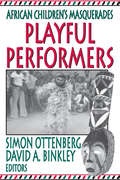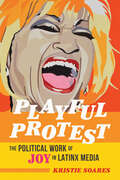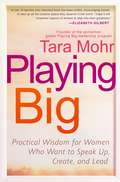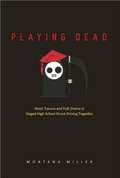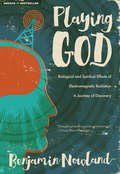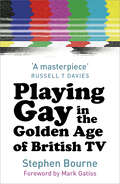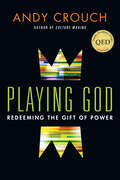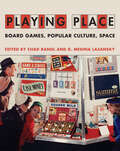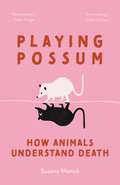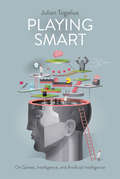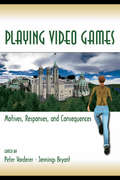- Table View
- List View
Playful Performers: African Children's Masquerades
by David BinkleyAfrican children develop aesthetic sensibilities at an early age, roughly from four to fourteen years. By the time they become full-fledged adolescents they may have had up to ten years experience with various art forms--masking, music, costuming, dancing, and performance. Aesthetic learning is vital to their maturation. The contributors to this volume argue that the idea that learning the aesthetics of a culture only occurs after maturity is false, as is the idea that children wearing masks is only play, and is not to be taken seriously.Playful Performers is a study of children's masquerades in Africa. The contributors describe specific cases of young children's masking in the areas of west, central, and southern Africa, which also happen to be the major areas of adult masquerading. The volume reveals the considerable creativity and ingenuity that children exhibit in preparing costumes, masks and musical instruments, and in playing music, dancing, singing, and acting. The book includes over 50 pages of black and white photographs, which illustrate and elaborate upon the authors' main points. The editors describe general categories of children's masquerades. In each of the three masking categories children's relationships to their parents and other adults differ, from a close relationship to some independence to almost complete independence. No other major work has covered this aspect of African children at this age level. The book offers a challenging perspective on young children, seeing them as active agents in their own culture rather than passive recipients of culture as taught by parents and other elders. It will be interesting reading for anthropologists, art historians, educators, and African studies specialists alike.
Playful Protest: The Political Work of Joy in Latinx Media (Feminist Media Studies)
by Kristie SoaresPleasure-based politics in Puerto Rican and Cuban pop culture Joy is a politicized form of pleasure that goes beyond gratification to challenge norms of gender, sexuality, race, and class. Kristie Soares focuses on the diasporic media of Puerto Rico and Cuba to examine how music, public activist demonstrations, social media, sitcoms, and other areas of culture resist the dominant stories told about Latinx joy. As she shows, Latinx creators compose versions of joy central to social and political struggle and at odds with colonialist and imperialist narratives that equate joy with political docility and a lack of intelligence. Soares builds her analysis around chapters that delve into gozando in salsa music, precise joy among the New Young Lords Party, choteo in the comedy ¿Qué Pasa U.S.A.?, azúcar in the life and death of Celia Cruz, dale as Pitbull’s signature affect, and Alexandria Ocasio-Cortez’s use of silliness to take seriously political violence. Daring and original, Playful Protest examines how Latinx creators resist the idea that joy only exists outside politics and activist struggle.
Playful Visions: Optical Toys and the Emergence of Children's Media Culture (The\mit Press Ser.)
by Meredith A. BakThe kaleidoscope, the stereoscope, and other nineteenth-century optical toys analyzed as “new media” of their era, provoking anxieties similar to our own about children and screens.In the nineteenth century, the kaleidoscope, the thaumatrope, the zoetrope, the stereoscope, and other optical toys were standard accessories of a middle-class childhood, used both at home and at school. In Playful Visions, Meredith Bak argues that the optical toys of the nineteenth century were the “new media” of their era, teaching children to be discerning consumers of media—and also provoking anxieties similar to contemporary worries about children's screen time. Bak shows that optical toys—which produced visual effects ranging from a moving image to the illusion of depth—established and reinforced a new understanding of vision as an interpretive process. At the same time, the expansion of the middle class as well as education and labor reforms contributed to a new notion of childhood as a time of innocence and play. Modern media culture and the emergence of modern Western childhood are thus deeply interconnected.Drawing on extensive archival research, Bak discusses, among other things, the circulation of optical toys, and the wide visibility gained by their appearance as printed templates and textual descriptions in periodicals; expanding conceptions of literacy, which came to include visual acuity; and how optical play allowed children to exercise a sense of visual mastery. She examines optical toys alongside related visual technologies including chromolithography—which inspired both chromatic delight and chromophobia. Finally, considering the contemporary use of optical toys in advertising, education, and art, Bak analyzes the endurance of nineteenth-century visual paradigms.
Playground: A Childhood Lost Inside the Playboy Mansion
by Jennifer SaginorYou are six years old. Every day after school your father takes you to a sprawling castle filled with exotic animals, bowls of candy, and half-naked women catering to your every need. You have your own room. You have new friends. You have an uncle Hef who's always there for you. Welcome to the world of Playground, the true story of a young girl who grew up inside the Playboy Mansion. By the time she was fourteen, she'd done countless drugs, had a secret affair with Hef's girlfriend, and was already losing her grip on reality. Schoolwork, family, and "ordinary people" had no meaning behind the iron gates of the Mansion, where celebrities frolicked, pool parties abounded, and her own father -- Hugh Hefner's personal physician and best friend, the man nicknamed "Dr. Feel Good" -- typically held court. Every day was a party, every night was an adventure, and through it all was a young girl falling faster and faster down the rabbit hole -- trying desperately hard not to get lost.
Playhouses and Privilege: The Architecture of Elite Childhood
by Abigail A. Van SlyckExamining playhouses of the super-rich to understand how architecture contributed to the construction of elite identity and modern childhoodPlayhouses and Privilege explores children&’s playhouses built on British and American estates between the 1850s and the mid-1930s. Different from the prefabricated buildings that later populated suburban backyards, these playhouses were often fully functional cottages designed by well-known architects for British royalty, American industrialists, and Hollywood stars. As Abigail A. Van Slyck shows, these buildings were more than extravagant spaces to cultivate children&’s imaginations and fantasy lives. Reviewing a rich archive that includes extant buildings, site plans, family photographs, baby books, and intimate household correspondence, Van Slyck demonstrates that these structures were tools of social reproduction shaped by elite parents&’ attitudes toward child-rearing, education, and class privilege. Recognizing playhouses as stages for the purposeful performance of upper-class identity, she illuminates their importance in influencing children to internalize gendered codes of conduct as they enacted rituals of hospitality and learned how to supervise servants. From Queen Victoria and Prince Albert&’s Swiss Cottage, built on their Osborne estate in 1853, to the children&’s cottage constructed on the grounds of Cornelius Vanderbilt&’s Newport mansion in 1886, and from the miniature bungalow commissioned in 1926 for the Dodge Brothers Motor Company heiress to the corporate-sponsored glass-block playhouse given to Shirley Temple in 1936, Van Slyck surveys a variety of playhouses and their milieus to trace the evolution of elite childhood and the broader social practices of wealth. Playhouses and Privilege makes clear that, far from being frivolous, playhouses were carefully planned architectural manifestations of adult concerns, integral to the reproduction of class privilege.
Playing Around: Women and Infidelity
by Linda WolfeIntimate, explosive, revelatory American women talk about having been unfaithful to their primary sexual partners. Why did they cheat? How and where did they manage to meet with their lovers? Were the affairs more sexually satisfying than the women's primary relationships? More emotionally satisfying? Did they feel guilt? Did they keep their affairs secret or admit them to partners or friends? And, whether confessed or not, how did infidelity affect the women's lives? Intimate and explosive, Playing Around explores the pleasures and pains of female infidelity and illuminates women's participation in a behavior that is often viewed as predominantly male.
Playing Big
by Tara MohrA groundbreaking women's leadership expert and popular conference speaker gives women the practical skills to voice and implement the changes they want to see--in themselves and in the world In her coaching and programs for women, Tara Mohr saw how women were "playing small" in their lives and careers, were frustrated by it, and wanted to "play bigger." She has devised a proven way for them to achieve their dreams by playing big from the inside out. Mohr's work helping women play bigger has earned acclaim from the likes of Maria Shriver and Jillian Michaels, and has been featured on the Today show, CNN, and a host of other media outlets. Sheryl Sandberg's Lean In gave many women new awareness about what kinds of changes they need to make to become more successful; yet most women need help implementing them. In the tradition of Brené Brown's Daring Greatly, Playing Big provides real, practical tools to help women quiet self-doubt, identify their callings, "unhook" from praise and criticism, unlearn counterproductive good girl habits, and begin taking bold action. While not all women aspire to end up in the corner office, every woman aspires to something. Playing Big fills a major gap among women's career books; it isn't just for corporate women. The book offers tools to help every woman play bigger--whether she's an executive, community volunteer, artist, or stay-at-home mom. Thousands of women across the country have been transformed by Mohr's program, and now this book makes the ideas and practices available to everyone who is ready to play big.
Playing Big: Find Your Voice, Your Mission, Your Message
by Tara MohrA groundbreaking women's leadership expert and popular conference speaker gives women the practical skills to voice and implement the changes they want to see--in themselves and in the world In her coaching and programs for women, Tara Mohr saw how women were "playing small" in their lives and careers, were frustrated by it, and wanted to "play bigger." She has devised a proven way for them to achieve their dreams by playing big from the inside out. Mohr's work helping women play bigger has earned acclaim from the likes of Maria Shriver and Jillian Michaels, and has been featured on the Today show, CNN, and a host of other media outlets. Sheryl Sandberg's Lean In gave many women new awareness about what kinds of changes they need to make to become more successful; yet most women need help implementing them. In the tradition of Brené Brown's Daring Greatly, Playing Big provides real, practical tools to help women quiet self-doubt, identify their callings, "unhook" from praise and criticism, unlearn counterproductive good girl habits, and begin taking bold action. While not all women aspire to end up in the corner office, every woman aspires to something. Playing Big fills a major gap among women's career books; it isn't just for corporate women. The book offers tools to help every woman play bigger--whether she's an executive, community volunteer, artist, or stay-at-home mom. Thousands of women across the country have been transformed by Mohr's program, and now this book makes the ideas and practices available to everyone who is ready to play big.
Playing Cleopatra: Inventing the Female Celebrity in Third Republic France
by Holly GroutQuestions about the meaning of womanhood and femininity loomed large in late nineteenth- and early twentieth-century French culture. In Playing Cleopatra, Holly Grout uses the theater—specifically, Parisian stage performances of the Egyptian queen Cleopatra by Sarah Bernhardt, Colette, and Josephine Baker—to explore these cultural and political debates. How and why did portrayals of Cleopatra influence French attitudes regarding race, sexuality, and gender? To what extent did Bernhardt, Colette, and Baker manipulate the image of Cleopatra to challenge social norms and to generate new models of womanhood? Why was Cleopatra—an ancient, mythologized queen—the chosen vehicle for these spectacular expressions of modern womanhood? In the context of late nineteenth-century Egyptomania, Cleopatra’s eroticized image—as well as her controversial legacy of female empowerment—resonated in new ways with a French public engaged in reassessing feminine sexuality, racialized beauty, and national identity. By playing Cleopatra, Bernhardt, Colette, and Baker did more than personify a character; they embodied the myriad ways in which celebrity was racialized, gendered, and commoditized, and they generated a model of female stardom that set the stage for twentieth-century celebrity long before the Hollywood machine’s mass manufacture of “stars.” At the same time, these women engaged with broader debates regarding the meaning of womanhood, celebrity, and Frenchness in the tumultuous decades before World War II.Drawing on plays, periodicals, autobiographies, personal letters, memoirs, novels, works of art, and legislation, Playing Cleopatra contributes to a growing body of literature that examines how individuals subverted the prevailing gender norms that governed relations between the sexes in liberal democratic regimes. By offering employment, visibility, and notoriety, the theater provided an especially empowering world for women, in which the roles they played both reflected and challenged contemporary cultural currents. Through the various iterations in which Bernhardt, Colette, and Baker played Cleopatra, they not only resurrected an ancient queen but also appropriated her mystique to construct new narratives of womanhood.
Playing Dead
by Montana MillerAs the Grim Reaper pulls a student out of class to be a "victim" of drunk driving in a program called "Every 15 Minutes," Montana Miller observes the ritual through a folklorist's lens. Playing Dead examines why hundreds of American schools and communities each year organize these mock tragedies without any national sponsorship or coordination. Often, the event is complete with a staged accident in the parking lot, a life-flight helicopter, and faux eulogies for the "dead" students read in school assemblies. Grounding her research in play theory, frame theory, and theory of folk drama, Miller investigates key aspects of this emergent tradition, paying particular attention to its unplanned elements--enabled by the performance's spontaneous nature and the participants' tendency to stray from the intended frame. Miller examines such variations in terms of the program as a whole, analyzing its continued popularity and weighing its success as perceived by participants. Her fieldwork reveals a surprising aspect of Every 15 Minutes that typical studies of ritual do not include: It can be fun. Playing Dead is volume two of the series Ritual, Festival, and Celebration, edited by Jack Santino.
Playing Dead: A Journey Through the World of Death Fraud
by Elizabeth GreenwoodIs it still possible to fake your own death in the twenty-first century? With six figures of student loan debt, Elizabeth Greenwood was tempted to find out.So she sets off on a foray into the world of death fraud, where for $30,000 a consultant can make you disappear--but your suspicious insurance company might hire a private detective to dig up your coffin...only to find it filled with rocks. Greenwood tracks down a man who staged a kayaking accident and then returned to live in his own house while all his neighbors thought he was dead. She takes a call from Michael Jackson (yes, he's alive--or so some would have her believe), talks to people contemplating pseudocide, and gathers intel on black market morgues in the Philippines, where she may or may not succeed in obtaining some fraudulent goodies of her own. Along the way, she learns that love is a much less common motive than money, and that making your death look like a drowning virtually guarantees you'll be caught. (Disappearing while hiking, however, is a great way to go.) Playing Dead is an utterly fascinating and charmingly bizarre investigation into our all-too-human desire to escape from the lives we lead, and the men and women desperate enough to lose their identities--and their families--to begin again.
Playing Dead: Mock Trauma and Folk Drama in Staged High School Drunk Driving Tragedies (Ritual, Festival, and Celebration #2)
by Montana MillerAs the Grim Reaper pulls a student out of class to be a “victim” of drunk driving in a program called “Every 15 Minutes,” Montana Miller observes the ritual through a folklorist’s lens. Playing Dead examines why hundreds of American schools and communities each year organize these mock tragedies without any national sponsorship or coordination. Often, the event is complete with a staged accident in the parking lot, a life-flight helicopter, and faux eulogies for the “dead” students read in school assemblies. Grounding her research in play theory, frame theory, and theory of folk drama, Miller investigates key aspects of this emergent tradition, paying particular attention to its unplanned elements—enabled by the performance’s spontaneous nature and the participants’ tendency to stray from the intended frame. Miller examines such variations in terms of the program as a whole, analyzing its continued popularity and weighing its success as perceived by participants. Her fieldwork reveals a surprising aspect of Every 15 Minutes that typical studies of ritual do not include: It can be fun. Playing Dead is volume two of the series Ritual, Festival, and Celebration, edited by Jack Santino.
Playing GOD
by Benjamin NowlandPlaying God guides us through the invisible. Benjamin Nowland moved to inner city Sydney in 2013 and soon after experienced acute symptoms of electromagnetic radiation pollution sickness. His physical, mental and spiritual health were profoundly affected. The only place he functioned was away from Wi-Fi, towers and mobile devices in a Zero EMF Sanctuary. In his search for truth, Ben questioned the suppression of scientific evidence. He asked why adverse health effects of Wi-Fi, mobile devices, and telco and NBN microwave towers are not shared with the public? What don't telcos and mobile manufacturers want us to know? In what he called the Sydney EMF Experiment he used himself as the subject to correlate effects of electromagnetic radiation. Insights were substantiated with extensive research. Tens of thousands of dollars in products and mainstream and alternative therapies were tested during his two-year journey. Playing God provides a streamlined path to discover the invisible. It introduces the new concept of 'spiritual effects' of electromagnetic radiation and inspires us to walk our own unique path to optimal physical and mental health.
Playing Gay in the Golden Age of British TV
by Mark Gatiss Stephen Bourne Russell T DaviesTHE TELEVISION SET – the humble box in the corner of almost every British household – has brought about some of the biggest social changes in modern times. It gives us a window into the lives of people who are different from us: different classes, different races, different sexualities. And through this window, we’ve learnt that, perhaps, we’re not so different after all. Playing Gay in the Golden Age of British TV looks at gay male representation on and off the small screen – from the programmes that hinted at homoeroticism to Mary Whitehouse’s Clean Up TV campaign, and The Naked Civil Servant to the birth of Channel 4 as an exciting ‘alternative’ television channel. Here, acclaimed social historian Stephen Bourne tells the story of the innovation, experimentation, back-tracking and bravery that led British television to help change society for the better.
Playing God: Redeeming the Gift of Power
by Andy CrouchMidwest Publishing Association Award of Excellence Outreach Magazine Resource of the Year ForeWord Book of the Year Award Honorable Mention Power corrupts—as we've seen time and time again. People too often abuse their power and play god in the lives of others. Shady politicians, corrupt executives and ego-filled media stars have made us suspicious of those who wield influence and authority. They too often breed injustice by participating in what the Bible calls idolatry. Yet power is also the means by which we bring life, create possibilities, offer hope and make human flourishing possible. This is "playing god" as it is meant to be. If we are to do God's work—fight injustice, bring peace, create beauty and allow the image of God to thrive in those around us—how are we to do these things if not by power? With his trademark clear-headed analysis, Andy Crouch unpacks the dynamics of power that either can make human flourishing possible or can destroy the image of God in people. While the effects of power are often very evident, he uncovers why power is frequently hidden. He considers not just its personal side but the important ways power develops and resides in institutions. Throughout Crouch offers fresh insights from key biblical passages, demonstrating how Scripture calls us to discipline our power. Wielding power need not distort us or others, but instead can be stewarded well. An essential book for all who would influence their world for the good.
Playing Nature: Ecology in Video Games (Electronic Mediations #58)
by Alenda Y. ChangA potent new book examines the overlap between our ecological crisis and video games Video games may be fun and immersive diversions from daily life, but can they go beyond the realm of entertainment to do something serious—like help us save the planet? As one of the signature issues of the twenty-first century, ecological deterioration is seemingly everywhere, but it is rarely considered via the realm of interactive digital play. In Playing Nature, Alenda Y. Chang offers groundbreaking methods for exploring this vital overlap.Arguing that games need to be understood as part of a cultural response to the growing ecological crisis, Playing Nature seeds conversations around key environmental science concepts and terms. Chang suggests several ways to rethink existing game taxonomies and theories of agency while revealing surprising fundamental similarities between game play and scientific work.Gracefully reconciling new media theory with environmental criticism, Playing Nature examines an exciting range of games and related art forms, including historical and contemporary analog and digital games, alternate- and augmented-reality games, museum exhibitions, film, and science fiction. Chang puts her surprising ideas into conversation with leading media studies and environmental humanities scholars like Alexander Galloway, Donna Haraway, and Ursula Heise, ultimately exploring manifold ecological futures—not all of them dystopian.
Playing Oppression: The Legacy of Conquest and Empire in Colonialist Board Games
by Mary Flanagan Mikael JakobssonA striking analysis of popular board games&’ roots in imperialist reasoning—and why the future of play depends on reckoning with it.Board games conjure up images of innocuously enriching entertainment: family game nights, childhood pastimes, cooperative board games centered around resource management and strategic play. Yet in Playing Oppression, Mary Flanagan and Mikael Jakobsson apply the incisive frameworks of postcolonial theory to a broad historical survey of board games to show how these seemingly benign entertainments reinforce the logic of imperialism.Through this lens, the commercialized version of Snakes and Ladders takes shape as the British Empire&’s distortion of Gyan Chaupar (an Indian game of spiritual knowledge), and early twentieth-century &“trading games&” that fêted French colonialism are exposed for how they conveniently sanitized its brutality while also relying on crudely racist imagery. These games&’ most explicitly abhorrent features may no longer be visible, but their legacy still lingers in the contemporary Eurogame tendency to exalt (and incentivize) cycles of exploration, expansion, exploitation, and extermination.An essential addition to any player&’s bookshelf, Playing Oppression deftly analyzes this insidious violence and proposes a path forward with board games that challenge colonialist thinking and embrace a much broader cultural imagination.
Playing Out of Bounds: “Belonging” and the North American Chinese Invitational Volleyball Tournament (G - Reference, Information and Interdisciplinary Subjects)
by Yuka NakamuraPlaying Out of Bounds investigates the North American Chinese Invitational Volleyball Tournament (NACIVT), an annual event that began in the 1930s in the streets of Manhattan and now attracts 1200 competitors from the U.S. and Canada. Its two key features are the 9-man game, where there are nine instead of the usual six volleyball players on the court, and the fact that player eligibility is limited to "100% Chinese" and Asian players, as defined in the tournament rules. These rules that limit competitors to specific ethno-racial groups is justified by the discrimination that Chinese people faced when they were denied access to physical activity spaces, and instead played in the alleyways and streets of Chinatowns. Drawing on interviews, participant-observation, and analysis of websites and tournament documents, Playing Out of Bounds explores how participants understand and negotiate their sense of belonging within this community of volleyball players and how membership within and the boundaries of this community are continually being (re)defined. This identity/community building occurs within a context of anti-Asian racism, growing numbers of mixed race players, and fluidity of what it means to be Canadian, American, Chinese, and Asian.
Playing Place: Board Games, Popular Culture, Space
by D. Medina Lasansky Chad RandlAn essay collection exploring the board game&’s relationship to the built environment, revealing the unexpected ways that play reflects perceptions of space.Board games harness the creation of entirely new worlds. From the medieval warlord to the modern urban planner, players are permitted to inhabit a staggering variety of roles and are prompted to incorporate preexisting notions of placemaking into their decisions. To what extent do board games represent the social context of their production? How might they reinforce or subvert normative ideas of community and fulfillment? In Playing Place, Chad Randl and D. Medina Lasansky have curated a collection of thirty-seven fascinating essays, supplemented by a rich trove of photo illustrations, that unpack these questions with breadth and care.Although board games are often recreational objects, their mythologies and infrastructure do not exist in a vacuum—rather, they echo and reproduce prevalent cultural landscapes. This thesis forms the throughline of pieces reflecting on subjects as diverse as the rigidly gendered fantasies of classic mass-market games; the imperial convictions embedded in games that position player-protagonists as conquerors establishing dominion over their &“discoveries&”; and even the uncanny prescience of games that have players responding to a global pandemic. Representing a thrilling convergence of historiography, architectural history, and media studies scholarship, Playing Place suggests not only that tabletop games should be taken seriously but also that the medium itself is uniquely capable of facilitating our critical consideration of structures that are often taken for granted.
Playing Possum: How Animals Understand Death
by Susana MonsóHow animals conceive of death and dying—and what it can teach us about our own relationships with mortalityWhen the opossum feels threatened, she becomes paralyzed. Her body temperature plummets, her breathing and heart rates drop to a minimum, and her glands simulate the smell of a putrefying corpse. Playing Possum explores what the opossum and other creatures can teach us about how we and other species understand mortality, and demonstrates that the concept of death, far from being a uniquely human attribute, is widespread in the animal kingdom.With humor and empathy, Susana Monsó tells the stories of ants who attend their own funerals, chimpanzees who clean the teeth of their dead, dogs who snack on their caregivers, crows who avoid the places where they saw a carcass, elephants obsessed with collecting ivory, and whales who carry their dead for weeks. Monsó, one of today&’s leading experts on animal cognition and ethics, shows how there are more ways to conceive of mortality than the human way, and challenges the notion that the only emotional reactions to death worthy of our attention are ones that resemble our own.Blending philosophical insight with new evidence from behavioral science and comparative psychology, Playing Possum dispels the anthropocentric biases that cloud our understanding of the natural world, and reveals that, when it comes to death and dying, we are just another animal.
Playing Smart: On Games, Intelligence, and Artificial Intelligence (Playful Thinking)
by Julian TogeliusA new vision of the future of games and game design, enabled by AI. Can games measure intelligence? How will artificial intelligence inform games of the future? In Playing Smart, Julian Togelius explores the connections between games and intelligence to offer a new vision of future games and game design. Video games already depend on AI. We use games to test AI algorithms, challenge our thinking, and better understand both natural and artificial intelligence. In the future, Togelius argues, game designers will be able to create smarter games that make us smarter in turn, applying advanced AI to help design games. In this book, he tells us how. Games are the past, present, and future of artificial intelligence. In 1948, Alan Turing, one of the founding fathers of computer science and artificial intelligence, handwrote a program for chess. Today we have IBM's Deep Blue and DeepMind's AlphaGo, and huge efforts go into developing AI that can play such arcade games as Pac-Man. Programmers continue to use games to test and develop AI, creating new benchmarks for AI while also challenging human assumptions and cognitive abilities. Game design is at heart a cognitive science, Togelius reminds us—when we play or design a game, we plan, think spatially, make predictions, move, and assess ourselves and our performance. By studying how we play and design games, Togelius writes, we can better understand how humans and machines think. AI can do more for game design than providing a skillful opponent. We can harness it to build game-playing and game-designing AI agents, enabling a new generation of AI-augmented games. With AI, we can explore new frontiers in learning and play.
Playing Together: 101 Terrific Games and Activities That Children Ages 3-9 Can Do Together
by Wendy SmolenSmolen makes getting siblings, cousins, or neighborhood children of different ages together an easy task, providing a collection of outdoor and indoor games and arts and crafts projects adapted to satisfy the interests and skills of children of various ages simultaneously.
Playing Video Games: Motives, Responses, and Consequences (Routledge Communication Series)
by Peter Vorderer Jennings BryantFrom security training simulations to war games to role-playing games, to sports games to gambling, playing video games has become a social phenomena, and the increasing number of players that cross gender, culture, and age is on a dramatic upward trajectory. Playing Video Games: Motives, Responses, and Consequences integrates communication, psychology, and technology to examine the psychological and mediated aspects of playing video games. It is the first volume to delve deeply into these aspects of computer game play. It fits squarely into the media psychology arm of entertainment studies, the next big wave in media studies. The book targets one of the most popular and pervasive media in modern times, and it will serve to define the area of study and provide a theoretical spine for future research.This unique and timely volume will appeal to scholars, researchers, and graduate students in media studies and mass communication, psychology, and marketing.
Playing War: Military Video Games After 9/11
by Matthew Thomas PayneExplores the culture that made military shooter video games popular, and key in understanding the War on TerrorNo video game genre has been more popular or more lucrative in recent years than the “military shooter.” Franchises such as Call of Duty, Battlefield, and those bearing Tom Clancy’s name turn over billions of dollars annually by promising to immerse players in historic and near-future battles, converting the reality of contemporary conflicts into playable, experiences. In the aftermath of 9/11, these games transformed a national crisis into fantastic and profitable adventures, where seemingly powerless spectators became solutions to these virtual Wars on Terror. Playing War provides a cultural framework for understanding the popularity of military-themed video games and their significance in the ongoing War on Terror. Matthew Payne examines post-9/11 shooter-style game design as well as gaming strategies to expose how these practices perpetuate and challenge reigning political beliefs about America’s military prowess and combat policies. Far from offering simplistic escapist pleasures, these post-9/11 shooters draw on a range of nationalist mythologies, positioning the player as the virtual hero at every level. Through close readings of key games, analyses of marketing materials, and participant observations of the war gaming community, Playing War examines an industry mobilizing anxieties about terrorism and invasion to craft immersive titles that transform international strife into interactive fun.
Playing With Fire: Feminist Thought And Activism Through Seven Lives In India
by Richa Nagar Sangtin WritersSeven voices contribute to this rare glimpse of the work being done on the front lines of the fight for social change in India. Playing with Fire is written in the collective voice of women employed by a large NGO as activists in their communities and is based on diaries, interviews, and conversations among them. Together their personal stories reveal larger themes and questions of sexism, casteism, and communalism, and a startling picture emerges of how NGOs both nourish and stifle local struggles for solidarity. The Hindi edition of the book, Sangtin Yatra, published in 2004, created controversy that resulted in backlash against the authors by their employer. The publication also drew support for the women and instigated a public conversation about the issues exposed in the book. Here, Richa Nagar addresses the dispute in the context of the politics of NGOs and feminist theory, articulating how development ideology employed by aid organizations serves to reinforce the domination of those it claims to help. The Sangtin Writers, Anupamlata, Ramsheela, Reshma Ansari, Richa Singh, Shashibala, Shashi Vaish, Surbala, and Vibha Bajpayee, are grassroots activists and members of a small organization called Sangtin in Uttar Pradesh, India. Richa Nagar teaches women’s studies at the University of Minnesota.
